Moons of Neptune

The planetNeptunehas 16 knownmoons,which are named for minorwater deitiesand awater creatureinGreek mythology.[note 1]By far the largest of them isTriton,discovered byWilliam Lassellon 10 October 1846, 17 days after the discovery of Neptune itself. Over a century passed before the discovery of the second natural satellite,Nereid,in 1949, and another 40 years passed beforeProteus,Neptune's second-largest moon, was discovered in 1989.
Triton is unique among moons ofplanetary massin that its orbit isretrogradeto Neptune's rotation andinclinedrelative to Neptune's equator, which suggests that it did not form in orbit around Neptune but was instead gravitationally captured by it. The next-largest satellite in theSolar Systemsuspected to be captured,Saturn's moonPhoebe,has only 0.03% of Triton's mass. The capture of Triton, probably occurring some time after Neptune formed a satellite system, was a catastrophic event for Neptune's original satellites, disrupting their orbits so that they collided to form a rubble disc. Triton is massive enough to have achievedhydrostatic equilibriumand to retain a thin atmosphere capable of forming clouds and hazes.
Inward of Triton are seven smallregular satellites,all of which haveprograde orbitsin planes that lie close to Neptune's equatorial plane; some of these orbit amongNeptune's rings.The largest of them is Proteus. They were re-accreted from the rubble disc generated after Triton's capture after the Tritonian orbit became circular. Neptune also has eight more outerirregular satellitesother than Triton, including Nereid, whose orbits are much farther from Neptune and at high inclination: three of these have prograde orbits, while the remainder have retrograde orbits. In particular, Nereid has an unusually close and eccentric orbit for an irregular satellite, suggesting that it may have once been a regular satellite that was significantly perturbed to its current position when Triton was captured. Neptune's outermost moonS/2021 N 1,which has an orbital period of about 27Earth years,orbits farther from its planet than any other known moon in theSolar System.[1][2]
History[edit]
Discovery[edit]
Tritonwas discovered byWilliam Lassellin 1846, just seventeen days after thediscovery of Neptune.[3]Nereidwas discovered byGerard P. Kuiperin 1949.[4]The third moon, later namedLarissa,was first observed by Harold J. Reitsema, William B. Hubbard, Larry A. Lebofsky andDavid J. Tholenon 24 May 1981. The astronomers were observing a star's close approach to Neptune, looking for rings similar tothose discovered around Uranusfour years earlier.[5]If rings were present, the star's luminosity would decrease slightly just before the planet's closest approach. The star's luminosity dipped only for several seconds, which meant that it was due to a moon rather than a ring.
No further moons were found untilVoyager 2flew by Neptune in 1989.Voyager 2rediscovered Larissa and discovered five inner moons:Naiad,Thalassa,Despina,GalateaandProteus.[6]In 2001, two surveys using large ground-based telescopes found five additional outer irregular moons, bringing the total to thirteen.[7]Follow-up surveys by two teams in 2002 and 2003 respectively re-observed all five of these moons, which areHalimede,Sao,Psamathe,Laomedeia,andNeso.[7][8]The 2002 survey also found a sixth moon, but it could not be re-observed enough times to determine its orbit, and it thus becamelost.[7]
In 2013Mark R. ShowalterdiscoveredHippocampwhile examining Hubble Space Telescope images of Neptune'sring arcsfrom 2009. He used a technique similar topanningto compensate for orbital motion and allowstackingof multiple images to bring out faint details.[9][10]After deciding on a whim to expand the search area to radii well beyond the rings, he found an unambiguous dot that represented the new moon.[11]He then found it repeatedly in other archival HST images going back to 2004.Voyager 2,which had observed all of Neptune's other inner satellites, did not detect it during its 1989 flyby, due to its dimness.[9]
In 2021,Scott S. Sheppardand colleagues used theSubaru TelescopeatMauna Kea, Hawaiiand discovered two more irregular moons of Neptune, which were announced in 2024.[12]These two moons areprovisionally designatedS/2021 N 1andS/2002 N 5.The latter turned out to be a recovery of the lost moon from 2002.[2][13]
Discovery of outer planet moons
Graphs are unavailable due to technical issues. There is more info onPhabricatorand onMediaWiki.org. |
Names[edit]
Triton did not have an official name until the twentieth century. The name "Triton" was suggested byCamille Flammarionin his 1880 bookAstronomie Populaire,[14]but it did not come into common use until at least the 1930s.[15]Until this time it was usually simply known as "the satellite of Neptune". Other moons of Neptune are also named for Greek and Romanwater gods,in keeping withNeptune's position as god of the sea:[16]either fromGreek mythology,usually children ofPoseidon,the Greek equivalent of Neptune (Triton, Proteus, Despina, Thalassa); lovers of Poseidon (Larissa); other mythological creatures related to Poseidon (Hippocamp); classes of minor Greek water deities (Naiad,Nereid); or specific Nereids (Halimede, Galatea, Neso, Sao, Laomedeia, Psamathe).[16][17]
For the "normal" irregular satellites, the general convention is to use names ending in "a" for prograde satellites, names ending in "e" for retrograde satellites, and names ending in "o" for exceptionally inclined satellites, exactly like the convention for themoons of Jupiter.[18]Twoasteroidsshare the same names as moons of Neptune:74 Galateaand1162 Larissa.
Characteristics[edit]
The moons of Neptune can be divided into two groups:regularandirregular.The first group includes the seven inner moons, which follow circular prograde orbits lying in the equatorial plane of Neptune. The second group consists of all nine other moons including Triton. They generally follow inclined eccentric and often retrograde orbits far from Neptune; the only exception is Triton, which orbits close to the planet following a circular orbit, though retrograde and inclined.[19]
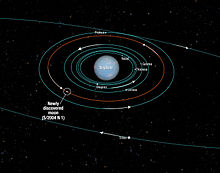
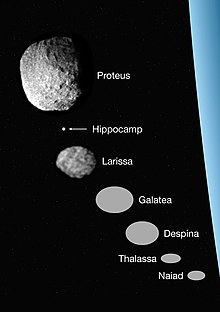
Regular moons[edit]
In order of distance from Neptune, the regular moons areNaiad,Thalassa,Despina,Galatea,Larissa,Hippocamp,andProteus.All but the outer two are within Neptune-synchronous orbit(Neptune's rotational period is 0.6713 day or 16 hours[20]) and thus are beingtidally decelerated.Naiad, the closest regular moon, is also the second smallest among the inner moons (following the discovery of Hippocamp), whereas Proteus is the largest regular moon and the second largest moon of Neptune. The first five moons orbit much faster than Neptune's rotation itself ranging from 7 hours forNaiadandThalassa,to 13 hours forLarissa.
The inner moons are closely associated withNeptune's rings.The two innermost satellites, Naiad and Thalassa, orbit between theGalleandLeVerrier rings.[6]Despina may be ashepherd moonof the LeVerrier ring, because its orbit lies just inside this ring.[21]The next moon,Galatea,orbits just inside the most prominent of Neptune's rings, theAdams ring.[21]This ring is very narrow, with a width not exceeding 50 km,[22]and has five embedded brightarcs.[21]The gravity of Galatea helps confine the ring particles within a limited region in the radial direction, maintaining the narrow ring. Variousresonancesbetween the ring particles and Galatea may also have a role in maintaining the arcs.[21]
Only the two largest regular moons have been imaged with a resolution sufficient to discern their shapes and surface features.[6]Larissa, about 200 km in diameter, is elongated. Proteus is not significantly elongated, but not fully spherical either:[6]it resembles an irregularpolyhedron,with several flat or slightlyconcavefacets 150 to 250 km in diameter.[23]At about 400 km in diameter, it is larger than the Saturnian moonMimas,which is fully ellipsoidal. This difference may be due to a past collisional disruption of Proteus.[24]The surface of Proteus is heavily cratered and shows a number of linear features. Its largest crater, Pharos, is more than 150 km in diameter.[6][23]
All of Neptune's inner moons are dark objects: theirgeometric albedoranges from 7 to 10%.[25]Theirspectraindicate that they are made from water ice contaminated by some very dark material, probably complexorganic compounds.In this respect, the inner Neptunian moons are similar to the innerUranian moons.[6]
Irregular moons[edit]

In order of their distance from the planet, the irregular moons areTriton,Nereid,Halimede,Sao,S/2002 N 5,Laomedeia,Psamathe,Neso,andS/2021 N 1,a group that includes both prograde and retrograde objects.[19]The seven outermost moons are similar to the irregular moons of othergiant planets,and are thought to have been gravitationally captured by Neptune, unlike the regular satellites, which probably formedin situ.[8]
Triton and Nereid are unusual irregular satellites and are thus treated separately from the other seven irregular Neptunian moons, which are more like the outer irregular satellites of the other outer planets.[8]Firstly, they are the largest two known irregular moons in the Solar System, with Triton being almost anorder of magnitudelarger than all other known irregular moons. Secondly, they both have atypically small semi-major axes, with Triton's being over an order of magnitude smaller than those of all other known irregular moons. Thirdly, they both have unusual orbital eccentricities: Nereid has one of the most eccentric orbits of any known irregular satellite, and Triton's orbit is a nearly perfect circle. Finally, Nereid also has the lowest inclination of any known irregular satellite.[8]
Triton[edit]
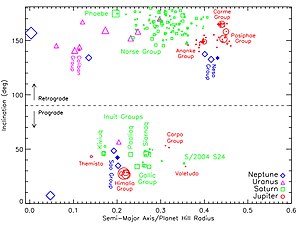
Triton follows a retrograde and quasi-circular orbit, and is thought to be a gravitationally captured satellite. It was the second moon in the Solar System that was discovered to have a substantialatmosphere,which is primarilynitrogenwith small amounts ofmethaneandcarbon monoxide.[26]The pressure on Triton's surface is about 14μbar.[26]In 1989 theVoyager 2spacecraft observed what appeared to be clouds and hazes in this thin atmosphere.[6]Triton is one of the coldest bodies in the Solar System, with a surface temperature of about 38 K (−235.2 °C).[26]Its surface is covered by nitrogen, methane,carbon dioxideand waterices[27]and has a highgeometric albedoof more than 70%.[6]TheBond albedois even higher, reaching up to 90%.[6][note 2]Surface features include the large southernpolar cap,older cratered planes cross-cut bygrabenandscarps,as well as youthful features probably formed by endogenic processes likecryovolcanism.[6]Voyager 2observations revealed a number of activegeyserswithin the polar cap heated by the Sun, which eject plumes to the height of up to 8 km.[6]Triton has a relatively high density of about 2 g/cm3indicating thatrocksconstitute about two thirds of its mass, and ices (mainly water ice) the remaining one third. There may be a layer of liquid water deep inside Triton, forming a subterranean ocean.[28]Because of its retrograde orbit and relative proximity to Neptune (closer than the Moon is to Earth),tidal decelerationis causing Triton to spiral inward, which will lead to its destruction in about 3.6 billion years.[29]
Nereid[edit]
Nereid is the third-largest moon of Neptune. It has a prograde but very eccentric orbit and is believed to be a former regular satellite that was scattered to its current orbit through gravitational interactions during Triton's capture.[30]Water ice has been spectroscopically detected on its surface. Early measurements of Nereid showed large, irregular variations in its visible magnitude, which were speculated to be caused by forcedprecessionor chaotic rotation combined with an elongated shape and bright or dark spots on the surface.[31]This was disproved in 2016, when observations from theKepler space telescopeshowed only minor variations. Thermal modeling based on infrared observations from theSpitzerandHerschelspace telescopes suggest that Nereid is only moderately elongated which disfavours forced precession of the rotation.[32]The thermal model also indicates that the surface roughness of Nereid is very high, likely similar to the Saturnian moonHyperion.[32]
Nereid dominates the normal irregular satellites of Neptune, having about 98% of the mass of Neptune's entire irregular satellite system altogether (if Triton is not counted). This is similar to the situation ofPhoebeat Saturn. If it is counted as a normal irregular satellite (but not Triton), then Nereid is also by far the largest normal irregular satellite known, having about two-thirds the mass of all normal irregular moons combined.[33]
Normal irregular moons[edit]
Among the remaining irregular moons, Sao, S/2002 N 5, and Laomedeia follow prograde orbits, whereas Halimede, Psamathe, Neso and S/2021 N 1 follow retrograde orbits. There are at least two groups of moons that share similar orbits, with the prograde moons Sao, S/2002 N 5, and Laomedeia belonging to the Sao group and the retrograde moons Psamathe, Neso, and S/2021 N 1 belonging to the Neso group.[12]The moons of the Neso group have the largest orbits of any natural satellites discovered in the Solar System to date, with average orbital distances over 125 times the distance between Earth and the Moon and orbital periods over 25 years.[34]Neptune has the largestHill spherein the Solar System, owing primarily to its large distance from the Sun; this allows it to retain control of such distant moons.[19]Nevertheless, the Jovian moons in theCarmeandPasiphae groupsorbit at a greater percentage of their primary's Hill radius than the Neso group moons.[19]
Formation[edit]
The mass distribution of the Neptunian moons is the most lopsided of the satellite systems of thegiant planetsin the Solar System. One moon, Triton, makes up nearly all of the mass of the system, with all other moons together comprising only one third of one percent. This is similar to the moon system of Saturn, whereTitanmakes up more than 95% of the total mass, but is different from the more balanced systems of Jupiter and Uranus. The reason for the lopsidedness of the present Neptunian system is that Triton was captured well after the formation of Neptune's original satellite system, and experts conjecture much of the system was destroyed in the process of capture.[30][35]
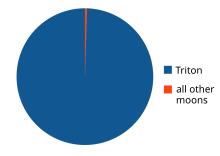
Triton's orbit upon capture would have been highly eccentric, and would have caused chaotic perturbations in the orbits of the original inner Neptunian satellites, causing them to collide and reduce to a disc of rubble.[30]This means it is likely that Neptune's present inner satellites are not the original bodies that formed with Neptune. Only after Triton's orbit became circularised could some of the rubble re-accrete into the present-day regular moons.[24]
The mechanism of Triton's capture has been the subject of several theories over the years. One of them postulates that Triton was captured in athree-bodyencounter. In this scenario, Triton is the surviving member of abinaryKuiper beltobject[note 3]disrupted by its encounter with Neptune.[36]
Numerical simulations show that there is a 0.41 probability that the moon Halimede collided with Nereid at some time in the past.[7]Although it is not known whether any collision has taken place, both moons appear to have similar ( "grey" ) colors, implying that Halimede could be a fragment of Nereid.[37]
List[edit]
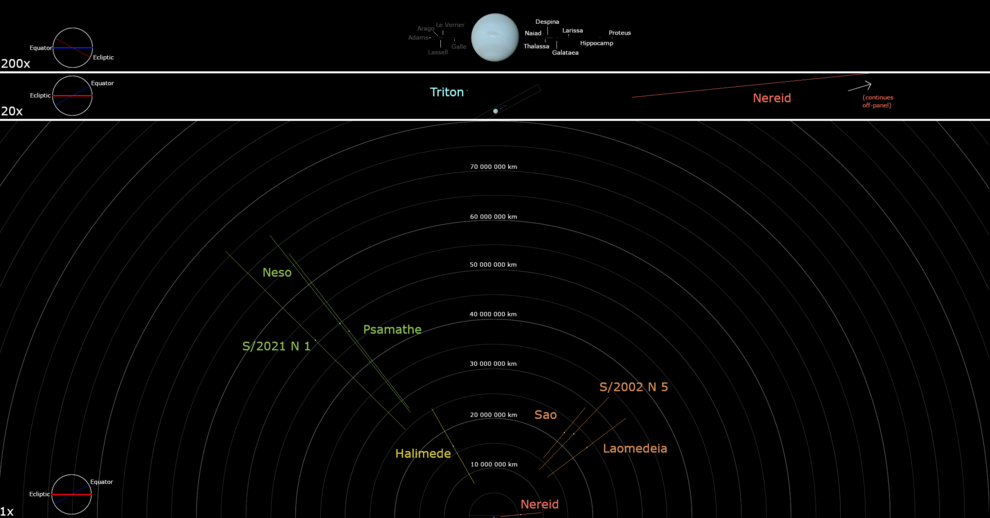
The Neptunian moons are listed here by orbital period, from shortest to longest. Irregular (captured) moons are marked by color. The orbits and mean distances of the irregular moons are variable over short timescales due to frequent planetary and solarperturbations,therefore the listed orbital elements of all irregular moons are averaged over a 30,000-year period: these may differ fromosculatingorbital elements provided by other sources.[38]Their orbital elements are all based on theepochof 1 January 2020.[1]Triton, the only Neptunian moon massive enough for its surface to havecollapsedinto aspheroid,is emboldened.
| Key | |||||
|---|---|---|---|---|---|
Inner moons |
♠ Triton |
† Nereid |
‡ Halimede |
♦ Sao group |
♥ Neso group |
| Label [note 4] |
Name | Pronunciation (key) |
Image | Abs. magn. |
Diameter (km)[note 5] |
Mass (×1016kg) [note 6] |
Semi-major axis (km)[17] |
Orbital period (d)[1] |
Orbital inclination (°)[1] |
Eccentricity [17][note 7] |
Discovery year[16] |
Year announced | Discoverer [16] |
Group |
|---|---|---|---|---|---|---|---|---|---|---|---|---|---|---|
| III | Naiad | /ˈneɪəd,ˈnaɪæd/[42] | 9.6 | 60.4 (96 × 60 × 52) |
≈ 13 | 48224 | +0.2944 | 4.691 | 0.0047 | 1989 | 1989 | Voyager Science Team | inner | |
| IV | Thalassa | /θəˈlæsə/ | 8.7 | 81.4 (108 × 100 × 52) |
≈ 35 | 50074 | +0.3115 | 0.135 | 0.0018 | 1989 | 1989 | Voyager Science Team | inner | |
| V | Despina | /dəˈspaɪnə/ | 7.3 | 156 (180 × 148 × 128) |
≈ 170 | 52526 | +0.3346 | 0.068 | 0.0004 | 1989 | 1989 | Voyager Science Team | inner | |
| VI | Galatea | /ˌɡæləˈtiːə/ |  |
7.2 | 174.8 (204 × 184 × 144) |
≈ 280 | 61953 | +0.4287 | 0.034 | 0.0001 | 1989 | 1989 | Voyager Science Team | inner |
| VII | Larissa | /ləˈrɪsə/ | 6.8 | 194 (216 × 204 × 168) |
≈ 380 | 73548 | +0.5555 | 0.205 | 0.0012 | 1981 | 1981 | Reitsema et al. | inner | |
| XIV | Hippocamp | /ˈhɪpəkæmp/ | 10.5 | 34.8±4.0 | ≈ 2.2 | 105283 | +0.9500 | 0.064 | 0.0005 | 2013 | 2013 | Showalteret al. | inner | |
| VIII | Proteus | /ˈproʊtiəs/ |  |
5.0 | 420 (436 × 416 × 402) |
≈ 3900 | 117646 | +1.1223 | 0.075 | 0.0005 | 1989 | 1989 | Voyager Science Team | inner |
| I | Triton♠ | /ˈtraɪtən/ | –1.2 | 2705.2±4.8 (2709 × 2706 × 2705) |
2139000 | 354759 | −5.8769 | 156.865 | 0.0000 | 1846 | 1846 | Lassell | ||
| II | Nereid† | /ˈnɪəriəd/ |  |
4.4 | 357 ± 13 | ≈ 2400 | 5504000 | +360.14 | 5.8 | 0.749 | 1949 | 1949 | Kuiper | |
| IX | Halimede‡ | /ˌhæləˈmiːdiː/ | 10.0 | ≈ 62 | ≈ 12 | 16590500 | −1879.78 | 119.6 | 0.521 | 2002 | 2003 | Holmanet al. | ||
| XI | Sao♦ | /ˈseɪoʊ/ | 11.1 | ≈ 44 | ≈ 3.4 | 22239900 | +2919.43 | 50.2 | 0.296 | 2002 | 2003 | Holman et al. | Sao | |
| S/2002 N 5♦ | 11.2 | ≈ 38 | ≈ 3 | 23414700 | +3156.56 | 46.3 | 0.433 | 2002 | 2024 | Holman et al. | Sao | |||
| XII | Laomedeia♦ | /ˌleɪəməˈdiːə/ | 10.8 | ≈ 42 | ≈ 3.4 | 23499900 | +3176.13 | 36.9 | 0.419 | 2002 | 2003 | Holman et al. | Sao | |
| X | Psamathe♥ | /ˈsæməθiː/ | 11.0 | ≈ 40 | ≈ 2.9 | 47615100 | −9149.51 | 127.8 | 0.414 | 2003 | 2003 | Sheppardet al. | Neso | |
| XIII | Neso♥ | /ˈniːsoʊ/ | 10.7 | ≈ 60 | ≈ 11 | 49895300 | −9794.99 | 128.4 | 0.455 | 2002 | 2003 | Holman et al. | Neso | |
| S/2021 N 1♥ | 12.1 | ≈ 25 | ≈ 0.8 | 50700200 | −10036.65 | 135.2 | 0.503 | 2021 | 2024 | Sheppard et al. | Neso |
See also[edit]
Notes[edit]
- ^This is a IAU guideline that will be followed at the naming of every Neptunian moon, although two (S/2002 N 5andS/2021 N 1) have yet to receive permanent names.
- ^The geometric albedo of an astronomical body is the ratio of its actual brightness at zerophase angle(i.e. as seen from the light source) to that of an idealized flat, fully reflecting,diffusively scattering(Lambertian) disk with the same cross-section. The Bond albedo, named after the American astronomerGeorge Phillips Bond(1825–1865), who originally proposed it, is the fraction ofpowerin the totalelectromagnetic radiationincident on an astronomical body that is scattered back out into space. The Bond albedo is a value strictly between 0 and 1, as it includes all possible scattered light (but not radiation from the body itself). This is in contrast to other definitions ofalbedosuch as the geometric albedo, which can be above 1. In general, though, the Bond albedo may be greater or smaller than the geometric albedo, depending on surface and atmospheric properties of the body in question.
- ^Binary objects,objects with moons such as thePluto–Charonsystem, are quite common among the largertrans-Neptunian objects(TNOs). Around 11% of all TNOs may be binaries.[36]
- ^Label refers to theRoman numeralattributed to each moon in order of their discovery.[16]
- ^Diameters with multiple entries such as "60×40×34" reflect that the body is not spherical and that each of its dimensions has been measured well enough to provide a 3-axis estimate. The dimensions of the five inner moons were taken from Karkoschka, 2003.[25]Dimensions of Proteus are from Stooke, 1994.[23]Dimensions of Triton are from Thomas, 2000,[39]whereas its diameter is taken from Davies et al., 1991.[40]The size of Nereid is from Kiss et al., 2016,[32]and the sizes of the other outer moons are from Sheppard, with the diameters of S/2002 N 5 and S/2021 N 1 calculated assuming an albedo of 0.04.[34]
- ^Of all known moons of Neptune, only Triton has a reliably measured mass.[41]The masses of all regular satellites were estimated by JPL,[41]while all other irregular moons of Neptune were calculated assuming a density of 1 g/cm3.
- ^Since the reference Showalter et al. (2019) does not cover irregular moons (with colored background), their eccentricities are taken from Planetary Satellite Mean Elements of JPL.[1]
References[edit]
- ^abcde"Planetary Satellite Mean Elements".Jet Propulsion Laboratory.Archivedfrom the original on 5 October 2021.Retrieved28 February2024.Note: Orbital elements of regular satellites are with respect to theLaplace plane,while orbital elements of irregular satellites are with respect to theecliptic.Inclinations greater than 90° are retrograde. Orbital periods of irregular satellites may not be consistent with their semi-major axes due to perturbations.
- ^ab"MPEC 2024-D112: S/2021 N 1".Minor Planet Electronic Circular.Minor Planet Center. 23 February 2024.Archivedfrom the original on 5 March 2024.Retrieved23 February2024.
- ^ Lassell, W. (1846)."Discovery of supposed ring and satellite of Neptune".Monthly Notices of the Royal Astronomical Society.7:157.Bibcode:1846MNRAS...7..157L.doi:10.1093/mnras/7.9.154.
- ^ Kuiper, Gerard P. (1949)."The Second Satellite of Neptune".Publications of the Astronomical Society of the Pacific.61(361): 175–176.Bibcode:1949PASP...61..175K.doi:10.1086/126166.
- ^ Reitsema, Harold J.; Hubbard, William B.; Lebofsky, Larry A.; Tholen, David J. (1982). "Occultation by a Possible Third Satellite of Neptune".Science.215(4530): 289–291.Bibcode:1982Sci...215..289R.doi:10.1126/science.215.4530.289.PMID17784355.S2CID21385195.
- ^abcdefghijkSmith, B. A.; Soderblom, L. A.; Banfield, D.; Barnet, C.; Basilevsky, A. T.; Beebe, R. F.; Bollinger, K.; Boyce, J. M.; Brahic, A. (1989)."Voyager 2 at Neptune: Imaging Science Results".Science.246(4936): 1422–1449.Bibcode:1989Sci...246.1422S.doi:10.1126/science.246.4936.1422.PMID17755997.S2CID45403579.Archivedfrom the original on 2020-08-04.Retrieved2019-06-25.
- ^abcdHolman, M. J.;Kavelaars, J. J.;Grav, T.; et al. (2004)."Discovery of five irregular moons of Neptune"(PDF).Nature.430(7002): 865–867.Bibcode:2004Natur.430..865H.doi:10.1038/nature02832.PMID15318214.S2CID4412380.Archived(PDF)from the original on 2 November 2013.Retrieved24 October2011.
- ^abcd Sheppard, Scott S.;Jewitt, David C.;Kleyna, Jan(2006). "A Survey for" Normal "Irregular Satellites around Neptune: Limits to Completeness".The Astronomical Journal.132(1): 171–176.arXiv:astro-ph/0604552.Bibcode:2006AJ....132..171S.doi:10.1086/504799.S2CID154011.
- ^ab"Hubble Finds New Neptune Moon".Space Telescope Science Institute.2013-07-15.Archivedfrom the original on 2016-03-04.Retrieved2021-01-28.
- ^Showalter, M. R.(2013-07-15)."How to Photograph a Racehorse...and how this relates to a tiny moon of Neptune".Mark Showalter's blog.Archivedfrom the original on 2013-07-18.Retrieved2013-07-16.
- ^Kelly Beatty (15 July 2013)."Neptune's Newest Moon".Sky & Telescope.Archivedfrom the original on 16 July 2013.Retrieved12 June2017.
- ^ab"New Uranus and Neptune Moons".Earth & Planetary Laboratory.Carnegie Institution for Science. 23 February 2024.Archivedfrom the original on 23 February 2024.Retrieved23 February2024.
- ^"MPEC 2024-D114: S/2002 N 5".Minor Planet Electronic Circular.Minor Planet Center. 23 February 2024.Archivedfrom the original on 3 March 2024.Retrieved23 February2024.
- ^Flammarion, Camille (1880).Astronomie populaire(in French). Flammarion. p. 591.ISBN2-08-011041-1.Archivedfrom the original on 2012-03-01.Retrieved2009-03-04.
- ^Moore, Patrick(April 1996).The planet Neptune: an historical survey before Voyager.Wiley-Praxis Series in Astronomy and Astrophysics (2nd ed.).John Wiley & Sons.pp. 150 (see p. 68).ISBN978-0-471-96015-7.OCLC33103787.
- ^abcde"Planet and Satellite Names and Discoverers".Gazetteer of Planetary Nomenclature.USGS Astrogeology.Archivedfrom the original on 2010-07-03.Retrieved2022-06-23.
- ^abcShowalter, M. R.; de Pater, I.; Lissauer, J. J.; French, R. S. (2019)."The seventh inner moon of Neptune"(PDF).Nature.566(7744): 350–353.Bibcode:2019Natur.566..350S.doi:10.1038/s41586-019-0909-9.PMC6424524.PMID30787452.Archived(PDF)from the original on 2019-02-22.Retrieved2019-02-22.
- ^M. Antonietta Barucci; Hermann Boehnhardt; Dale P. Cruikshank; Alessandro Morbidelli, eds. (2008)."Irregular Satellites of the Giant Planets"(PDF).The Solar System Beyond Neptune.University of Arizona Press. p. 414.ISBN9780816527557.Archived fromthe original(PDF)on 2017-08-10.Retrieved2017-07-22.
- ^abcdJewitt, David; Haghighipour, Nader (2007)."Irregular Satellites of the Planets: Products of Capture in the Early Solar System"(PDF).Annual Review of Astronomy and Astrophysics.45(1): 261–95.arXiv:astro-ph/0703059.Bibcode:2007ARA&A..45..261J.doi:10.1146/annurev.astro.44.051905.092459.S2CID13282788.Archived(PDF)from the original on 2014-02-25.Retrieved2010-09-27.
- ^Williams, David R. (1 September 2004)."Neptune Fact Sheet".NASA.Archivedfrom the original on 1 July 2010.Retrieved18 July2013.
- ^abcd Miner, Ellis D.; Wessen, Randii R.; Cuzzi, Jeffrey N. (2007)."Present knowledge of the Neptune ring system".Planetary Ring System.Springer Praxis Books.ISBN978-0-387-34177-4.
- ^ Horn, Linda J.; Hui, John; Lane, Arthur L.; Colwell, Joshua E. (1990). "Observations of Neptunian rings by Voyager photopolarimeter experiment".Geophysical Research Letters.17(10): 1745–1748.Bibcode:1990GeoRL..17.1745H.doi:10.1029/GL017i010p01745.
- ^abc Stooke, Philip J. (1994). "The surfaces of Larissa and Proteus".Earth, Moon, and Planets.65(1): 31–54.Bibcode:1994EM&P...65...31S.doi:10.1007/BF00572198.S2CID121825800.
- ^ab Banfield, Don; Murray, Norm (October 1992). "A dynamical history of the inner Neptunian satellites".Icarus.99(2): 390–401.Bibcode:1992Icar...99..390B.doi:10.1016/0019-1035(92)90155-Z.
- ^ab Karkoschka, Erich (2003). "Sizes, shapes, and albedos of the inner satellites of Neptune".Icarus.162(2): 400–407.Bibcode:2003Icar..162..400K.doi:10.1016/S0019-1035(03)00002-2.
- ^abcElliot, J. L.; Strobel, D. F.; Zhu, X.; Stansberry, J. A.; Wasserman, L. H.; Franz, O. G. (2000)."The Thermal Structure of Triton's Middle Atmosphere"(PDF).Icarus.143(2): 425–428.Bibcode:2000Icar..143..425E.doi:10.1006/icar.1999.6312.Archived(PDF)from the original on 2012-02-23.Retrieved2010-05-22.
- ^ Cruikshank, D.P.; Roush, T.L.; Owen, T.C.; Geballe, T.R.; et al. (6 August 1993). "Ices on the surface of Triton".Science.261(5122): 742–745.Bibcode:1993Sci...261..742C.doi:10.1126/science.261.5122.742.PMID17757211.S2CID38283311.
- ^Hussmann, Hauke; Sohl, Frank; Spohn, Tilman (November 2006)."Subsurface oceans and deep interiors of medium-sized outer planet satellites and large trans-neptunian objects".Icarus.185(1): 258–273.Bibcode:2006Icar..185..258H.doi:10.1016/j.icarus.2006.06.005.Archived(PDF)from the original on 2015-08-31.Retrieved2019-06-09.
- ^ Chyba, C. F.;Jankowski, D. G.; Nicholson, P. D. (July 1989). "Tidal evolution in the Neptune-Triton system".Astronomy and Astrophysics.219(1–2): L23–L26.Bibcode:1989A&A...219L..23C.
- ^abc Goldreich, P.; Murray, N.; Longaretti, P. Y.; Banfield, D. (1989). "Neptune's story".Science.245(4917): 500–504.Bibcode:1989Sci...245..500G.doi:10.1126/science.245.4917.500.PMID17750259.S2CID34095237.
- ^ Shaefer, Bradley E.; Tourtellotte, Suzanne W.; Rabinowitz, David L.; Schaefer, Martha W. (2008). "Nereid: Light curve for 1999–2006 and a scenario for its variations".Icarus.196(1): 225–240.arXiv:0804.2835.Bibcode:2008Icar..196..225S.doi:10.1016/j.icarus.2008.02.025.S2CID119267757.
- ^abc Kiss, C.; Pál, A.; Farkas-Takács, A. I.; Szabó, G. M.; Szabó, R.; Kiss, L. L.; Molnár, L.; Sárneczky, K.; Müller, T. G.; Mommert, M.; Stansberry, J. (11 April 2016)."Nereid from space: Rotation, size and shape analysis from Kepler/K2, Herschel and Spitzer observations"(PDF).Monthly Notices of the Royal Astronomical Society.457(3): 2908–2917.arXiv:1601.02395.Bibcode:2016MNRAS.457.2908K.doi:10.1093/mnras/stw081.ISSN0035-8711.S2CID54602372.
- ^Denk, Tilmann (2024)."Outer Moons of Saturn".tilmanndenk.de.Tilmann Denk.Archivedfrom the original on 24 February 2024.Retrieved25 February2024.
- ^abSheppard, Scott S."Neptune Moons".sites.google.Archivedfrom the original on 22 April 2022.Retrieved26 April2022.
- ^Naeye, R. (September 2006). "Triton Kidnap Caper".Sky & Telescope.112(3): 18.Bibcode:2006S&T...112c..18N.
- ^abAgnor, C.B.; Hamilton, D.P. (2006)."Neptune's capture of its moon Triton in a binary-planet gravitational encounter"(PDF).Nature.441(7090): 192–4.Bibcode:2006Natur.441..192A.doi:10.1038/nature04792.PMID16688170.S2CID4420518.Archived(PDF)from the original on 2013-11-03.Retrieved2006-09-13.
- ^Grav, Tommy;Holman, Matthew J.;Fraser, Wesley C. (2004-09-20). "Photometry of Irregular Satellites of Uranus and Neptune".The Astrophysical Journal.613(1): L77–L80.arXiv:astro-ph/0405605.Bibcode:2004ApJ...613L..77G.doi:10.1086/424997.S2CID15706906.
- ^ Brozović, Marina; Jacobson, Robert A. (May 2022)."Orbits of the Irregular Satellites of Uranus and Neptune".The Astronomical Journal.163(5): 12.Bibcode:2022AJ....163..241B.doi:10.3847/1538-3881/ac617f.S2CID248458067.241.
- ^ Thomas, P.C. (2000)."NOTE: The Shape of Triton from Limb Profiles".Icarus.148(2): 587–588.Bibcode:2000Icar..148..587T.doi:10.1006/icar.2000.6511.
- ^ Davies, Merton E.; Rogers, Patricia G.; Colvin, Tim R. (1991). "A control network of Triton".Journal of Geophysical Research.96(E1): 15, 675–681.Bibcode:1991JGR....9615675D.doi:10.1029/91JE00976.
- ^ab"Planetary Satellite Physical Parameters".Jet Propulsion Laboratory.Archivedfrom the original on 28 March 2022.Retrieved28 March2022.
- ^Jones, Daniel(2003) [1917], Peter Roach; James Hartmann; Jane Setter (eds.),English Pronouncing Dictionary,Cambridge: Cambridge University Press,ISBN3-12-539683-2
















